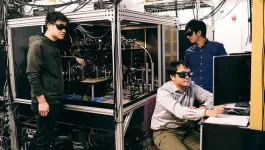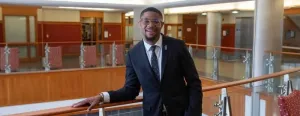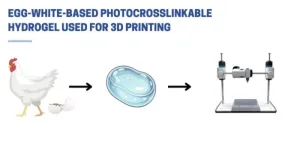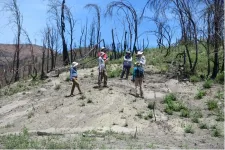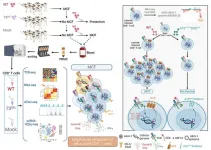(Press-News.org) Researchers at Purdue University have trapped alkali atoms (cesium) on an integrated photonic circuit, which behaves like a transistor for photons (the smallest energy unit of light) similar to electronic transistors. These trapped atoms demonstrate the potential to build a quantum network based on cold-atom integrated nanophotonic circuits. The team, led by Chen-Lung Hung, associate professor of physics and astronomy at the Purdue University College of Science, published their discovery in the American Physical Society’s Physical Review X.
“We developed a technique to use lasers to cool and tightly trap atoms on an integrated nanophotonic circuit, where light propagates in a small photonic ‘wire’ or, more precisely, a waveguide that is more than 200 times thinner than a human hair,” explains Hung, who is also a member of the Purdue Quantum Science and Engineering Institute. “These atoms are ‘frozen’ to negative 459.67 degrees Fahrenheit or merely 0.00002 degrees above the absolute zero temperature and are essentially standing still. At this cold temperature, the atoms can be captured by a ‘tractor beam’ aimed at the photonic waveguide and are placed over it at a distance much shorter than the wavelength of light, around 300 nanometers or roughly the size of a virus. At this distance, the atoms can very efficiently interact with photons confined in the photonic waveguide. Using state-of-the-art nanofabrication instruments in the Birck Nanotechnology Center, we pattern the photonic waveguide in a circular shape at a diameter of around 30 microns (three times smaller than a human hair) to form a so-called microring resonator. Light would circulate within the microring resonator and interact with the trapped atoms.”
A key aspect function the team demonstrates in this research is that this atom-coupled microring resonator serves like a ‘transistor’ for photons. They can use these trapped atoms to gate the flow of light through the circuit. If the atoms are in the correct state, photons can transmit through the circuit. Photons are entirely blocked if the atoms are in another state. The stronger the atoms interact with the photons, the more efficient this gate is.
“We have trapped up to 70 atoms that could collectively couple to photons and gate their transmission on an integrated photonic chip. This has not been realized before,” says Xinchao Zhou, graduate student at Purdue Physics and Astronomy. Zhou is also the recipient of this year’s Bilsand Dissertation Fellowship.
The entire research team is based out of Purdue University in West Lafayette, Indiana. Hung served as principal investigator and supervised the project. Zhou performed the experiment to trap atoms on the integrated circuit, which was designed and fabricated in-house by Tzu-Han Chang, a former postdoc now working with Prof. Sunil Bhave at the Birck Nanotechnology Center. The critical portions of the experiment were set up by Zhou and Hikaru Tamura, a former postdoc at Purdue at the time of the research and now an assistant professor at the Institute of Molecular Science in Japan.
“Our technique, which we detailed in the paper, allows us to very efficiently laser cool many atoms on an integrated photonic circuit. Once many atoms are trapped, they can collectively interact with light propagating on the photonic waveguide,” says Zhou. “This is unique for our system because all the atoms are the same and indistinguishable, so they could couple to light in the same way and build up phase coherence, allowing atoms to interact with light collectively with stronger strength. Just imagine a boat moving faster when all rowers row the boat in synchronization compared with unsynchronized motion. In contrast, solid-state emitters embedded in a photonic circuit are hardly ‘the same’ due to slightly different surroundings influencing each emitter. It is much harder for many solid-state emitters to build up phase coherence and collectively interact with photons like cold atoms. We could use cold atoms trapped on the circuit to study new collective effects,” says Hung.
The platform demonstrated in this research could provide a photonic link for future distributed quantum computing based on neutral atoms. It could also serve as a new experimental platform for studying collective light-matter interactions and for synthesizing quantum degenerate trapped gases or ultracold molecules.
“Unlike electronic transistors used in daily life, our atom-coupled integrated photonic circuit obeys the principles of quantum superposition,” explains Hung. “This allows us to manipulate and store quantum information in trapped atoms, which are quantum bits known as qubits. Our circuit may also efficiently transfer stored quantum information into photons that could ‘fly’ through the photonic wire and a fiber network to communicate with other atom-coupled integrated circuits or atom-photon interfaces. Our research demonstrates a potential to build a quantum network based on cold-atom integrated nanophotonic circuits.”
The team has been working on this research area for several years and plans to pursue it with vigor. Their past research discovery tied to this work include recent breakthroughs such as the realization of the ‘tractor beam’ method in 2023 listing Zhou as first author, and the realization of highly efficient optical fiber-coupling to a photonic chip in 2022 with a pending US patent application. New research directions have opened up due to the team’s successful demonstration of atoms being very efficiently cooled and trapped on a circuit. The future for this research is bright with many avenues to explore.
“There are several promising next steps to explore,” says Hung. “We could arrange the trapped atoms in an organized array along the photonic waveguide. These atoms can collectively couple to the waveguide through constructive interference but cannot radiate photons into the surrounding free space due to destructive interference. We aim to build the first nanophotonic platform to realize the so-called ‘selective radiance’ proposed by theorists in recent years to improve the fidelity of photon storage in a quantum system. We could also try to form new states of quantum matter on an integrated photonic circuit to study few- and many-body physics with atom-photon interactions. We could cool the atoms closer to the absolute zero temperature to reach quantum degeneracy so that the trapped atoms could form a gas of strongly interacting Bose-Einstein condensate. We may also try synthesizing cold molecules from the trapped atoms with the enhanced radiative coupling from the microring resonator.”
This work was supported by the U.S. Air Force Office of Scientific Research (Grant No. FA9550-22-1-0031) and the National Science Foundation (Grant No. PHY-1848316 and ECCS-2134931). This work was published with support from the Purdue University Libraries Open Access Publishing Fund. Quantum science and engineering is one of four dimensions within Purdue Computes, a major initiative that enables the university to advance to the forefront with unparalled excellence at scale.
About the Department of Physics and Astronomy at Purdue University
Purdue’s Department of Physics and Astronomy has a rich and long history dating back to 1904. Our faculty and students are exploring nature at all length scales, from the subatomic to the macroscopic and everything in between. With an excellent and diverse community of faculty, postdocs and students who are pushing new scientific frontiers, we offer a dynamic learning environment, an inclusive research community and an engaging network of scholars.
Physics and Astronomy is one of the seven departments within the Purdue University College of Science. World-class research is performed in astrophysics, atomic and molecular optics, accelerator mass spectrometry, biophysics, condensed matter physics, quantum information science, and particle and nuclear physics. Our state-of-the-art facilities are in the Physics Building, but our researchers also engage in interdisciplinary work at Discovery Park District at Purdue, particularly the Birck Nanotechnology Center and the Bindley Bioscience Center. We also participate in global research including at the Large Hadron Collider at CERN, many national laboratories (such as Argonne National Laboratory, Brookhaven National Laboratory, Fermilab, Oak Ridge National Laboratory, the Stanford Linear Accelerator, etc.), the James Webb Space Telescope, and several observatories around the world.
About Purdue University
Purdue University is a public research institution demonstrating excellence at scale. Ranked among top 10 public universities and with two colleges in the top four in the United States, Purdue discovers and disseminates knowledge with a quality and at a scale second to none. More than 105,000 students study at Purdue across modalities and locations, including nearly 50,000 in person on the West Lafayette campus. Committed to affordability and accessibility, Purdue’s main campus has frozen tuition 13 years in a row. See how Purdue never stops in the persistent pursuit of the next giant leap — including its first comprehensive urban campus in Indianapolis, the Mitchell E. Daniels, Jr. School of Business, Purdue Computes and the One Health initiative — at https://www.purdue.edu/president/strategic-initiatives.
Contributors:
Chen-Lung Hung, associate professor of physics and astronomy at the Purdue University College of Science
Xinchao Zhou, graduate student at Purdue Physics and Astronomy
Written by Cheryl Pierce, Communications Specialist
END
Purdue researchers trap atoms, forcing them to serve as photonic transistors
This groundbreaking research demonstrates a potential for quantum networks based on cold-atom integrated nanophotonic circuits
2024-07-29
ELSE PRESS RELEASES FROM THIS DATE:
Analogies for modeling belief dynamics
2024-07-29
Researchers who study belief dynamics often use analogies to understand and model the complex cognitive–social systems that underly why we believe the things we do and how those beliefs can change over time. Ideas can be transmitted like a virus, for instance, “infecting” a population as they spread from person to person. We might be drawn — like magnets — to others with a similar worldview. A society’s beliefs can shift slowly before reaching a tipping point that thrusts society into a new phase.
In a new paper in Trends in Cognitive Sciences, SFI Professor Mirta Galesic and ...
Many juvenile ‘lifers’ freed
2024-07-29
In 1953, 15-year-old Joe Ligon and four other Pennsylvania teens went on an alcohol-fueled tear that resulted in the stabbing deaths of two people and injuries to six more.
The teens were tried as a group, and all received life without parole.
After a series of U.S. Supreme Court decisions in 2012 and 2016 found that mandatory life sentences for juveniles was unconstitutional, Ligon’s case went to federal court. After 67 long years in prison, the case was decided in his favor in 2020.
Ligon was granted his freedom in 2021 — at 83 years of age and after ...
UW model shows cortical implants like Elon Musk’s Blindsight unlikely to ‘exceed normal human vision’
2024-07-29
Elon Musk recently declared on X that Blindsight, a cortical implant to restore vision, would have low resolution at first “but may ultimately exceed normal human vision.”
That pronouncement is unrealistic at best, according to new research from the University of Washington.
Ione Fine, lead author and UW professor of psychology, said Musk’s projection for the latest Neuralink project rests on the flawed premise that implanting millions of tiny electrodes into the visual cortex, the region of the brain that processes information received from the eye, will result in high-resolution vision.
For the study, ...
UVA's Data Justice Academy receives new funding from NSF
2024-07-29
The National Science Foundation will provide funding to the University of Virginia’s Data Justice Academy, the agency recently announced, support that will help the summer program continue to serve undergraduate students from groups that are historically underrepresented in data science.
Established in 2021, the Data Justice Academy provides a 10-week residential experience to participants in which they perform mentored research while learning technical skills.
The overriding goal of the Data Justice Academy, which is jointly managed by UVA’s School of Data Science and Equity Center, ...
Orthopedic surgeon-scientist Dr. Frank Henn named Chair of the Department of Orthopaedics
2024-07-29
University of Maryland School of Medicine (UMSOM) Dean Mark T. Gladwin, MD, announced today that R. Frank Henn, III, MD, Professor of Orthopaedics, who has served as Interim Chair of the Department since 2022, has been appointed to serve as the new Chair of UMSOM’s Department of Orthopaedics, effective immediately.
Dr. Henn, who joined the Department in 2010, is an academic leader and highly regarded, board-certified orthopaedic surgeon; he has published significant scientific research, and is a leading clinician focusing on the care of the shoulder and knee, with an emphasis in cartilage ...
Nature inspires a breakthrough: scientists develop revolutionary egg white-based bioink for advanced tissue engineering
2024-07-29
Los Angeles, California – July 29, 2024 - Terasaki Institute scientists have created a cutting-edge technology inspired by nature by developing a novel bioink derived from egg whites or Egg White methacryloyl (EWMA). Bioinks are mainly used in 3D bioprinting to create artificial tissues. These natural or synthetic materials support living cells, aiding their adhesion, growth, and differentiation. They are essential for developing complex tissue structures for medical research, drug testing, and organ transplantation. This novel EWMA bioink represents a promising addition to this field, offering a unique combination of properties that address many challenges faced in tissue engineering.
The ...
California a botanical and climate change hot spot
2024-07-29
From coastal redwoods and Joshua trees to golden poppies and sagebrush, California is a global botanical hotspot. It’s also a place confronted with extreme heat, wildfires and crumbling coastlines. The state’s natural beauty and history of pioneering conservation efforts make it a test bed for protecting biodiversity in the face of current and future climate change, argues a study led by the University of California, Davis.
Published July 29 in Proceedings of the National Academy of Sciences, the study, “Climate Change and California’s Terrestrial Biodiversity,” is part of a special ...
Young scientists face career hurdles in interdisciplinary research
2024-07-29
COLUMBUS, Ohio – Scientists agree that solving some of society’s greatest challenges in biomedicine such as food sustainability, aging and disease treatment will need researchers from a variety of scientific fields working together.
But a new study finds that the young scientists who most embrace interdisciplinary research face “career impediments” not seen in their peers who focus their work only within their own disciplines.
The results are troublesome and pose a “grave challenge” to efforts to increase interdisciplinary ...
New progress in research into malignant catarrhal fever in cattle
2024-07-29
A research team led by University of Liège scientists has published a groundbreaking study on malignant catarrhal fever (MCF). This disease is caused by the alcelaphine gammaherpesvirus 1 (AlHV-1), which infects its natural host, the wildebeest. This study sheds light on the mechanisms by which this virus, which is asymptomatic and latent in the wildebeest, causes an oligoclonal expansion of CD8+ T lymphocytes in cattle, leading to the development of MCF.
In 2013, the research team had already demonstrated (1) that malignant catarrhal fever (MCF), which is fatal in cattle, only develops if the AlHV-1 virus can maintain a ...
Words like ‘this’ and ‘that’ act as attention tools across languages
2024-07-29
All languages have words like ‘this’ and ‘that’ to distinguish between referents that are ‘near’ and ‘far’. Languages like English or Hebrew have two of these ‘demonstratives’. Languages like Spanish or Japanese use a three-word system. For instance, in Spanish, ‘este’ signals something close to the speaker, ‘ese’ signals something far from the speaker but close to the listener, and ‘aquel’ signals something far from both.
“The reason why we were interested in demonstratives is because of their ...
LAST 30 PRESS RELEASES:
Superradiant spins show teamwork at the quantum scale
Cleveland Clinic Research links tumor bacteria to immunotherapy resistance in head and neck cancer
First Editorial of 2026: Resisting AI slop
Joint ground- and space-based observations reveal Saturn-mass rogue planet
Inheritable genetic variant offers protection against blood cancer risk and progression
Pigs settled Pacific islands alongside early human voyagers
A Coral reef’s daily pulse reshapes microbes in surrounding waters
EAST Tokamak experiments exceed plasma density limit, offering new approach to fusion ignition
Groundbreaking discovery reveals Africa’s oldest cremation pyre and complex ritual practices
First breathing ‘lung-on-chip’ developed using genetically identical cells
How people moved pigs across the Pacific
Interaction of climate change and human activity and its impact on plant diversity in Qinghai-Tibet plateau
From addressing uncertainty to national strategy: an interpretation of Professor Lim Siong Guan’s views
Clinical trials on AI language model use in digestive healthcare
Scientists improve robotic visual–inertial trajectory localization accuracy using cross-modal interaction and selection techniques
Correlation between cancer cachexia and immune-related adverse events in HCC
Human adipose tissue: a new source for functional organoids
Metro lines double as freight highways during off-peak hours, Beijing study shows
Biomedical functions and applications of nanomaterials in tumor diagnosis and treatment: perspectives from ophthalmic oncology
3D imaging unveils how passivation improves perovskite solar cell performance
Enriching framework Al sites in 8-membered rings of Cu-SSZ-39 zeolite to enhance low-temperature ammonia selective catalytic reduction performance
AI-powered RNA drug development: a new frontier in therapeutics
Decoupling the HOR enhancement on PtRu: Dynamically matching interfacial water to reaction coordinates
Sulfur isn’t poisonous when it synergistically acts with phosphine in olefins hydroformylation
URI researchers uncover molecular mechanisms behind speciation in corals
Chitin based carbon aerogel offers a cleaner way to store thermal energy
Tracing hidden sources of nitrate pollution in rapidly changing rural urban landscapes
Viruses on plastic pollution may quietly accelerate the spread of antibiotic resistance
Three UH Rainbow Babies & Children’s faculty elected to prestigious American Pediatric Society
Tunnel resilience models unveiled to aid post-earthquake recovery
[Press-News.org] Purdue researchers trap atoms, forcing them to serve as photonic transistorsThis groundbreaking research demonstrates a potential for quantum networks based on cold-atom integrated nanophotonic circuits
